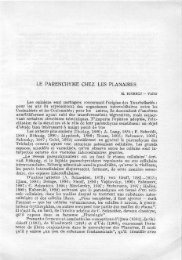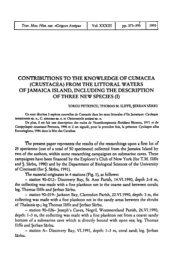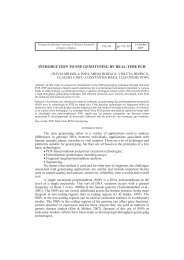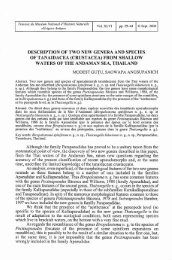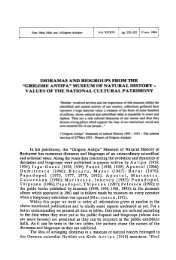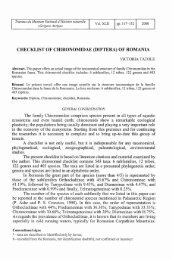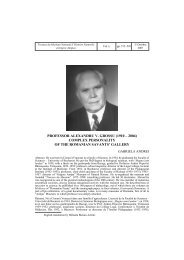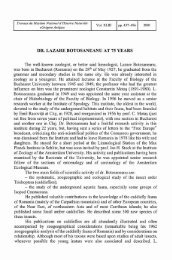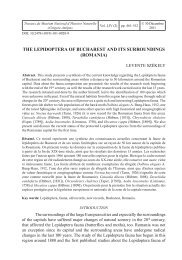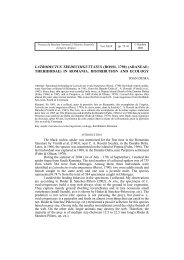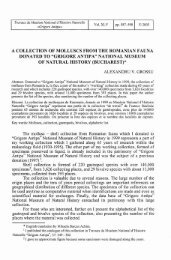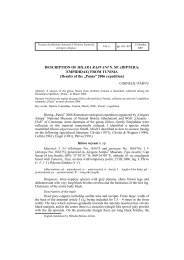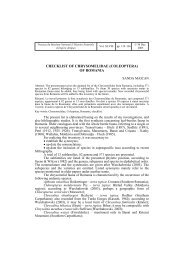sixty million years of evolution. part one: family botiidae - Travaux
sixty million years of evolution. part one: family botiidae - Travaux
sixty million years of evolution. part one: family botiidae - Travaux
Create successful ePaper yourself
Turn your PDF publications into a flip-book with our unique Google optimized e-Paper software.
<strong>Travaux</strong> du Musium National d'Histoire Naturelle<br />
((Grigore Antipaw<br />
Vol. XLIV<br />
pp. 309-333<br />
0 2002<br />
SIXTY MILLION YEARS OF EVOLUTION. PART ONE: FAMILY<br />
BOTIIDAE (PISCES: OSTARIOPHYSI: COBITOIDEA)*<br />
TEODOR T. NALBANT<br />
Motto: "The taxonomy must be an applied phylogeny"<br />
Emile G. Racovitza (1910)<br />
Abstract. A new classsification <strong>of</strong> cobitoid fishes is proposed based on their morphology, <strong>evolution</strong> and<br />
phylogeny. The <strong>evolution</strong> <strong>of</strong> cobitoid loaches began in the late Palaeocene, about 60 <strong>million</strong>s <strong>years</strong> ago<br />
from a catostomid ancestor and very soon the stem was divided in two lineages: the botiids lineage and<br />
the nemacheilid-cobitid lineage. In early Eocene the botiids stem was divided in vaillantellin clade and<br />
in botiin clade, both evolving slowly till present. The vaillantellins have only south east Asian genus<br />
Vaillantella with 3-4 species. The botiids are divided in the tribe Leptobotiini with 3 east Asian genera<br />
(Leptobotia, Parabotia and Sinibotia) and the tribe Botiini with 3 south and south-east Asian genera<br />
(Hymenophysa, Yasuhikotakia and Botia).<br />
Rtsumt. On propose une nouvelle classification des taxons ap<strong>part</strong>enant au groupe Cobitoidae,<br />
classification baste sur des caractkres morphologiques, sur I'tvolution et sur la phylogenie du groupe.<br />
L' tvolution a commenct env. 60 <strong>million</strong>s d'anntes et depuis le groupe s'est djvist en deux lignes<br />
Cvolutives: celle des fam.illes Botiidae et Namacheilidae - Cobitidae. Pendant 1'Eocene suptrieur les<br />
Botiides se sont divistes i leur tour en Vaillantellinae et en Botiinae. Les premitres ont un seul genre<br />
sud-est asiatique (Vaillantella) qui comprend 3-4 espkces. La famille Botiidae comprend 3 genres est<br />
asiatiques (Leptobotia, Parabotia et Sinibotia) et Botiini avec 3 genres sud-est et sud asiatiques<br />
(Hymenophysa, Yasuhikotakia et Botia).<br />
Key words: <strong>evolution</strong> <strong>of</strong> Botiidae, phylogeny, classification (Pisces: Cobitoidea).<br />
The botiids are <strong>one</strong> <strong>of</strong> the beloved group <strong>of</strong> fishes for the aquarists and also<br />
amateur ichthyologists, due to their beautiful and attractive colours and interesting<br />
shape <strong>of</strong> body. Their habits in aquarium made them as good companions for other<br />
fishes such as barbs, charachoids, small catfishes etc. Unfortunately, their<br />
systhematics was, for a long time, a controversial subject <strong>of</strong> discussion <strong>of</strong> many<br />
students.Therefore, the main aim <strong>of</strong> this contribution is to arrange their systematics<br />
based on their phylogeny. In this way, more than 30 <strong>of</strong> inner and outer<br />
morphological characters <strong>of</strong> botiids and their out-groups (nemacheilids, cobitids etc)<br />
were analysed and polarised. The results are herein presented.<br />
MATERIAL AND METHODS<br />
More than 300 cobitoid species (botiids, nemacheilids, and cobitids) were<br />
examined (measured, counted for meristics, dissected, cleared and stained etc.) in<br />
order to understand the phylogenetic value <strong>of</strong> each character. On the other hand, I<br />
evaluated the <strong>evolution</strong> and phylogeny <strong>of</strong> lineages on the basis <strong>of</strong> earth<br />
transformation (<strong>evolution</strong> <strong>of</strong> tectonic plates and hydrographic network), fossils<br />
(especially suborbital spines), climatic changes and magnetic reversals.<br />
* This paper is dedicated to the memory <strong>of</strong> Emile G. Racovitza, the forerunner <strong>of</strong> phylogenetical<br />
systemactics.
310 TEODOR T. NALBANT<br />
Most <strong>of</strong> the specimens came from the large loach collection "Biiniirescu-<br />
Nalbant" (formerly ISBB), now in the National Museum <strong>of</strong> Natural History<br />
"Grigore Antipa" Bucharest. Other specimens were obtained on loan from different<br />
institutions (see abbreviations), such as CAS, USNM, AMNH, MNHN, BMNH,<br />
MHNG, SMF, NRMS, ZMA, ZIAN, ZMB, NHMW, ZMC, etc. Other material was<br />
examined and studied directly in the collections <strong>of</strong> Chonbuk National University,<br />
Chonju (South Korea), Aristotelian University <strong>of</strong> Thessaloniki (Greece), Hacettepe<br />
University, Ankara (Turkey), Institute <strong>of</strong> Fisheries and Aquarium, Vama (Bulgaria).<br />
Abbreviations:<br />
AMNH: American Museum <strong>of</strong> Natural History, New York, N. Y.; BMNH: Natural History<br />
Museum, London; CAS: California Academy <strong>of</strong> Sciences, San Francisco, Ca; ISBB: Institutul de<br />
Biologie Bucurevti (now in MTNB, see below); MHNG: MusCum d'Histoire Naturelle, Genhe;<br />
MNHN: Museum National d'Histoire Naturelle, Paris; NHMW: Naturhistorisches Museum, Wien;<br />
MINB: Muzeul National de Istorie Naturals "Grigore Antipa", Bucurevti; NRMS: Natural History<br />
Museum, Stockholm; SMF: Senckenberg Museum u. Forschungsinstitut, Frankfurt am Main; USNM:<br />
National Museum <strong>of</strong> Natural History, Washington, D. C.; ZIAN: Zoologiceskii Institut, Akademii<br />
Nauk, Sankt Petersburg; ZMA: Zoological Museum, Amsterdam; ZMB: Zoologisches Museum der<br />
Humboldt Universitat, Berlin; ZMC: Zoologisk Museum, Copenhague.<br />
The different biogeographical concepts and unities presented in this paper are<br />
used almost in the same sense as defined by Biinlrescu (1990, 1992, 1995).<br />
However, there are several differences between us concerning the arrangement <strong>of</strong><br />
the genera and species in biogeographical unities or in <strong>evolution</strong> <strong>of</strong> the lineages.<br />
The drawings, excepting a few, are made by the author and by Dr Rudolf<br />
F. Mayer (Madrid) based on <strong>part</strong>s or dissected specimens, or, entire individuals.<br />
Characters. The polarization <strong>of</strong> each feature is presented after its definition.<br />
The nodes are characterised by their initial <strong>evolution</strong>, sometimes a few<br />
reversals being included, plus a new specialized character.<br />
1. Four rostral barbels (two pairs) each pair united at their base in a fleshy<br />
mobile pad; two maxillo-mandibular barbels (<strong>one</strong> pair ) in the comer <strong>of</strong> the mouth.<br />
Plesiomorphy, 0.<br />
2. Four rostal barbels (two pairs) separated at their base and two maxillo-<br />
mandibular barbels (<strong>one</strong> pair) in the corner <strong>of</strong> the mouth. Apomorphy, 1.<br />
3. Two rostral barbels (<strong>one</strong> pair), two maxillar barbels (<strong>one</strong> pair) on each <strong>part</strong><br />
<strong>of</strong> upper jaw and two maxillo-mandibular barbels (<strong>one</strong> pair) in each comer <strong>of</strong> the<br />
mouth.Autapomorphy, 2.<br />
4. Mobile suborbital spine (ect-ethmoid b<strong>one</strong>) present. Apomorphy, 1.<br />
5. No mobile suborbital spine (plesiomorphy, 0). In vaillantellins the absence<br />
<strong>of</strong> this spine is secondary, representing an autapomorphy, 2.<br />
6. Suborbital spine simple (plesiomorphy, 0). In some Bicanestrinia (Cobitis)<br />
species the loss <strong>of</strong> the <strong>one</strong> thorn is secondary, representing an autapomorphy, 2.<br />
7. Suborbital spine with the two thoms superimposed. Plesiomorphy, 0.<br />
8. Suborbital spine with the two thoms in horizontal plan. Apomorphy, 1.<br />
9. Both lips simple with no mental lobes. Plesiomorphy, 0.<br />
10. Both lips papillous or furrowed, with well developed mental lobes,<br />
sometimes as buttons or a fourth or fifth pair <strong>of</strong> barbel. Apomorphy, 1.<br />
1 1. Body generally high (deep bodied species). Plesiomorphy, 0.
SIXTY MILLION YEARS OF EVOLUTION: BOTIIDAE (PISCES) 31 1<br />
---<br />
12. Body generally low, some time serpentifom. Apomomorphy, 1.<br />
13. Dorsal fin rays with a normal number <strong>of</strong> branched' rays, i.e. 6-16.<br />
Plesiomorphy, 0.<br />
14. Dorsal fin with more than 30 branched rays. Apomorphy, 1.<br />
15. Dorsal fin placed generally in the midlle <strong>of</strong> the body. Plesiomorphy, 0.<br />
16. Dorsal fin placed well behind the middle <strong>of</strong> the body, sometimes its last<br />
rays above the insertion <strong>of</strong> anal fin. Apomorphy, 1.<br />
17. Sexual dimorphism absent or not evident. Plesiomorphy, 0.<br />
18. Sexual dimorphism present, expressed in males as osseous plates at the<br />
base <strong>of</strong> pectoral rays or buttons on lateral <strong>part</strong>s <strong>of</strong> head and fins. Apomorphy, 1.<br />
19. Sexual dimorphism expressed in males as a swell on each <strong>part</strong> <strong>of</strong> the body.<br />
Autapomorphy, 2.<br />
20. Lateral line complete and axial. Plesiomorphy, 0.<br />
21. Lateral line incomplete, in most cobitid loaches not exceending the length<br />
<strong>of</strong> pectorals. Apomorphy, 1.<br />
22. Scales present on the whole body.Plesiomorphy, 0.<br />
23. Body <strong>part</strong>ially covered by scales.Apomorphy, 1.<br />
24. Body completely nacked. Autapomorphy, 2.<br />
25. Scales generally elongate. Plesiomorphy, 0.<br />
26. Scales generally round. Apomorphy, 1.<br />
27. Scales with a very large focal z<strong>one</strong>. Apomorphy, 1.<br />
28. Body, sides <strong>of</strong> the head (sometimes on vertex) scalled. Apomorphy, 1.<br />
29. Caudal fin well forked. Plesiomorphy, 0.<br />
30. Caudal fin truncate or slightly rounded. Apomorphy, 1.<br />
3 1. Stomach syphonal. Plesiomorphy, 0.<br />
32. Stomach straight. Apomorphy, 1.<br />
33. Long intestine with a few loops. Plesiomorphy, 0.<br />
34. Intestine extremely long with numerous loops. Autapomorphy, 2.<br />
35. Short and straight intestine without loops. Apomorphy, 1.<br />
36. Gas-bladder with two developed fibrous chambers, sometimes the first<br />
covered <strong>part</strong>ially, very rare completely, by osseous substance. Plesiomorphy, 0.<br />
37. Gas-bladder with the first <strong>part</strong> formed by two chambers placed on each<br />
<strong>part</strong> <strong>of</strong> the vertebral column, both united by a duct and both being covered by<br />
osseous substance (including the duct). The second chamber fibrous, reduced to a<br />
diverticle or well developed (see also Rendahl, 1933 b and Ramaswami, 1953).<br />
Apomorphy, 1.<br />
38. Gas-bladder with the first chamber unique covered completely by osseous<br />
substance, the second <strong>one</strong> a short diverticle. Autapomorphy, 2.<br />
A study <strong>of</strong> the skeletal and muscular structures <strong>of</strong> the scapular girdle <strong>of</strong><br />
Rendahl (1933 a) has shown that in leptobotiins there are 11 generalized characters<br />
(i.e plesiomorphies) and only two specialized characters (i.e apomorphies). Among<br />
the plesiomorphic features there are: scapula without eminentia glenoidalis, the<br />
presence <strong>of</strong> a foramen coraco-cleithralis, the presence <strong>of</strong> a musculus abductor<br />
superficialis (pectoral rays) and the musculus abductor radialis inserted on<br />
coracoideum. According to Rendahl, in nemacheilids there are 8 plesiomorphies and<br />
5 apomorphies, and in cobitids there are 4 plesiomorphies and 14 apomorphies.
312 TEODOR T. NALBANT<br />
RESULTS<br />
The <strong>evolution</strong> <strong>of</strong>the cobitoid lineage. Correlations with Earth physics and<br />
climatic changes<br />
Wu and al., 1981, have demonstrated, on the basis <strong>of</strong> osteological characters,<br />
that the cobitoid loaches are undoubtely placed, toghether with gyrinocheilids, on<br />
the same big lineage <strong>of</strong> the catostomid fishes, whereas the cyprinids and<br />
homalopterids (i.e. balitorids) form another big lineage, the sister group <strong>of</strong> the<br />
former. Already, in Eocene fossils <strong>of</strong> the suckers were largely known in east Asia<br />
and especially in western North America (Cavender, 199 1, 1998).<br />
Fossils <strong>of</strong> loaches (nemacheilids) were known from Oligocene, but these<br />
cannot be surely ascribed to these fishes (Nalbant, 1963). The first undoubtely loach<br />
remains, <strong>of</strong> a mid Miocene age, were found in central Asia, in Kirghistan (Lebedev,<br />
1959) and in Kazakhstan along the west Mongolian border (Sytchevscaya, 1989).<br />
These remains represent only suborbital spines, all belonging to the genus Cobitis.<br />
According to these results, this genus was well defined at that time (mid Miocene)<br />
and therefore we must consider that its <strong>evolution</strong> begun much earlier, possibly in the<br />
early Oligocene, even in the late Eocene, probably from a misgumoid ancestor. If<br />
so, the origin and <strong>evolution</strong> <strong>of</strong> nemacheilids begun in the upper <strong>part</strong> <strong>of</strong> Palaeocene.<br />
The primitivest lineages <strong>of</strong> nemacheilids are those <strong>of</strong> actual genera Serpenticobitis<br />
and Ellopostoma (see PI. 7).<br />
Serpenticobitis retains a movable suborbital spine like in botiids but somewhat<br />
modified, i.e. the two thorns being disposed in horizontal plan like in cobitids.The<br />
roots <strong>of</strong> the four rostal barbels are well spaced like in all nemacheilids. Another<br />
nemacheilid feature <strong>of</strong> Serpenticobitis is the arrangement <strong>of</strong> gas-bladder based on<br />
two anterior encapsulated chambers united by a short duct and with a very reduced<br />
fibrous posterior chamber (see P1. 12, fig. 2 and in Nalbant, 2001, the plate). Both <strong>of</strong><br />
these features came from the node b ( P1. 7, see the phylogenetic arrangement <strong>of</strong><br />
clades) with origin in the late Palaeocene or in early Eocene. The lineage <strong>of</strong> botiids is<br />
the least as old as nemacheilid-cobitid lineage, at the end <strong>of</strong> Palaeocene, both stems<br />
being originated in the same node (0) possibly placed <strong>sixty</strong> <strong>million</strong> <strong>years</strong> ago. I<br />
consider that this represents the birth moment <strong>of</strong> the loach stem (Pl. 7).<br />
A hypothetical primitive loach had a high and compressed body, relativelly<br />
small eyes, body completely covered by small scales, two very close rostal barbels,<br />
but during the <strong>evolution</strong> each <strong>of</strong> them were splitted in another supplementary barbel,<br />
two maxillo-mandibular barbels, small inferior mouth, a nearly movable suborbital<br />
spine (ect-ethmoidal b<strong>one</strong>), forked caudal fin, gas-bladder consisting <strong>of</strong> two fibrous<br />
chambers, the anterior <strong>one</strong> globulous and the posterior <strong>one</strong> elongated, a syphonal<br />
stomach with a long intestine, complete lateral line and no sexual dimorphism.<br />
In early Eocene (node a) the botiid stem was splitted and its two lineages,<br />
Vaillantellinae and Botiinae, evolved independently. The former, vaillantellins,<br />
aquired three autapomorphies: they lost the possibility to use a movable suborbitar<br />
spine, an exaggerated length <strong>of</strong> body and an exaggerated length <strong>of</strong> the dorsal fin,<br />
with more than 50 branched rays. However, they retained a number <strong>of</strong> botiin<br />
features (see Nalbant and BiinZrescu, 1977), i. e. the arrangement <strong>of</strong> four rostra1<br />
barbels, complete lateral line, forked caudal fin, same type <strong>of</strong> gas-bladder, body<br />
laterally compressed, not evident sexual dimorphism.<br />
In his "An outline <strong>of</strong> Tertia~ypalaeogeography", Adams (1981: 221) pointed<br />
out that "The Tertiary geographical, oceanographical, climatological, faunal and<br />
floral changes which occurred this time, were considerable and closely interrelated.
SIXTY MILLION YEARS OF EVOLUTION: BOTlIDAE (PISCES) 313<br />
In paleogeographical terms, Cenozoic history charts the movement <strong>of</strong> the continents<br />
and the associated alterations in the ocean basins."<br />
The Tertiary period begun with the late Cretacic major extinctions as a result<br />
<strong>of</strong> a considerable climatic cooling associated with a severe sea drops. After the mid<br />
Palaeocene (see PI. 7) both curves <strong>of</strong> sea surface temperature and mean sea level<br />
increased.<br />
The shape and size <strong>of</strong> continents were changed and the hydrogeographic<br />
network was modified. During Palaeocene the magnetic reversals were reduced,<br />
generally the reverse polarity periods were dominant. Perhaps, the cobitoid stem<br />
was born during a change <strong>of</strong> polarity and then evolved slowly towards the Eocene<br />
epoch. Although the bradytely <strong>of</strong> its <strong>evolution</strong>, the initial cobitoid stem was splitted<br />
in two lineages, those <strong>of</strong> botiids and those <strong>of</strong> nemacheilid-cobitids, at the border<br />
between Palaeocene and Eocene. In the early Eocene the botiid stem was splitted<br />
from the node a into vaillantellin lineage and botiin lineage (see above node a). Both<br />
<strong>of</strong> these lineages evolved slowly till present without major complications. However,<br />
probably in the late Eocene the botiin lineage was divided in two directions <strong>of</strong><br />
<strong>evolution</strong> by changing the karyotype (see P1. 6): leptobotiins with normal diploid<br />
species 2n = 50 - 52 and botiins with tetraploid species 2n = 98 - 100 (Suzuki and<br />
Taki, 1996). The single leptobotiin tetraploid genus is Sinibotia. Even<br />
morphologically it appears very close to the botiin genus Hymenophysa. However,<br />
due to its complicate mouth mental lobes, quite simple gas-bladder and its east-<br />
Asian geographical distribution, I consider Sinibotia to belong rather to leptobotiins<br />
than to botiins. The changes <strong>of</strong> karyotype in botiid fishes at the end <strong>of</strong> Eocene<br />
appear very possible because this period was characterised by a general cooling<br />
process, a significant decreasing sea level, quite rapid changes in polarity, followed<br />
by a major process <strong>of</strong> extinctions (see P1. 7). The cobitid stem was originated also<br />
towards the late Eocene. Probably, this happened when India collided the Angarian<br />
(Asian) shield. Other changes in hydrography <strong>of</strong> this new super-continent took place<br />
and the new lineages <strong>of</strong> fishes were able to spread in different directions.<br />
In Oligocene period the changes <strong>of</strong> polarity were equilibrated but a severe<br />
drops <strong>of</strong> sea level made new extinctions. Perhaps this represents the moment <strong>of</strong> the<br />
begining <strong>of</strong> spreading and diversification <strong>of</strong> all three cobitoid stems.<br />
The Miocene is characterised by numerous and rapid changes <strong>of</strong> polarity and<br />
after the mid <strong>part</strong> <strong>of</strong> the period, a general deterioration <strong>of</strong> clime took place, till<br />
present. The general sea level decreased constantly (see Berggren and<br />
Hollister, 1974 and 1977, Briggs, 1996). All three groups <strong>of</strong> cobitoid loaches<br />
benefited by these physical modifications to spread and diversifying. Because that<br />
the botiids are the oldest lineage, their different elements were not be able to spread<br />
to much towards west. Genera Parabotia, Leptobotia and Sinibotia remained<br />
distributed only in all tributaries <strong>of</strong> the Pacific slope, whereas Hymenoplzysa and<br />
Yasuhikotakia are distributed in south-east Asia (including the big Sunda Islands)<br />
and south Asia till the Indus drainage (genus Botia).<br />
Neinacheilids and cobitids radiated in all freshwaters <strong>of</strong> Euro-Asiatic<br />
continent, from the high Hymalayan rapids to the lowland lakes and rivers <strong>of</strong> the<br />
same continents. It is very interesting that two cobitoids penetrated in the African<br />
shield; a Cobitis species live in a few "oueds" in north-west Africa and a<br />
nemacheilid fish is present in lake Tana, Ethiopia, north-east Africa.



